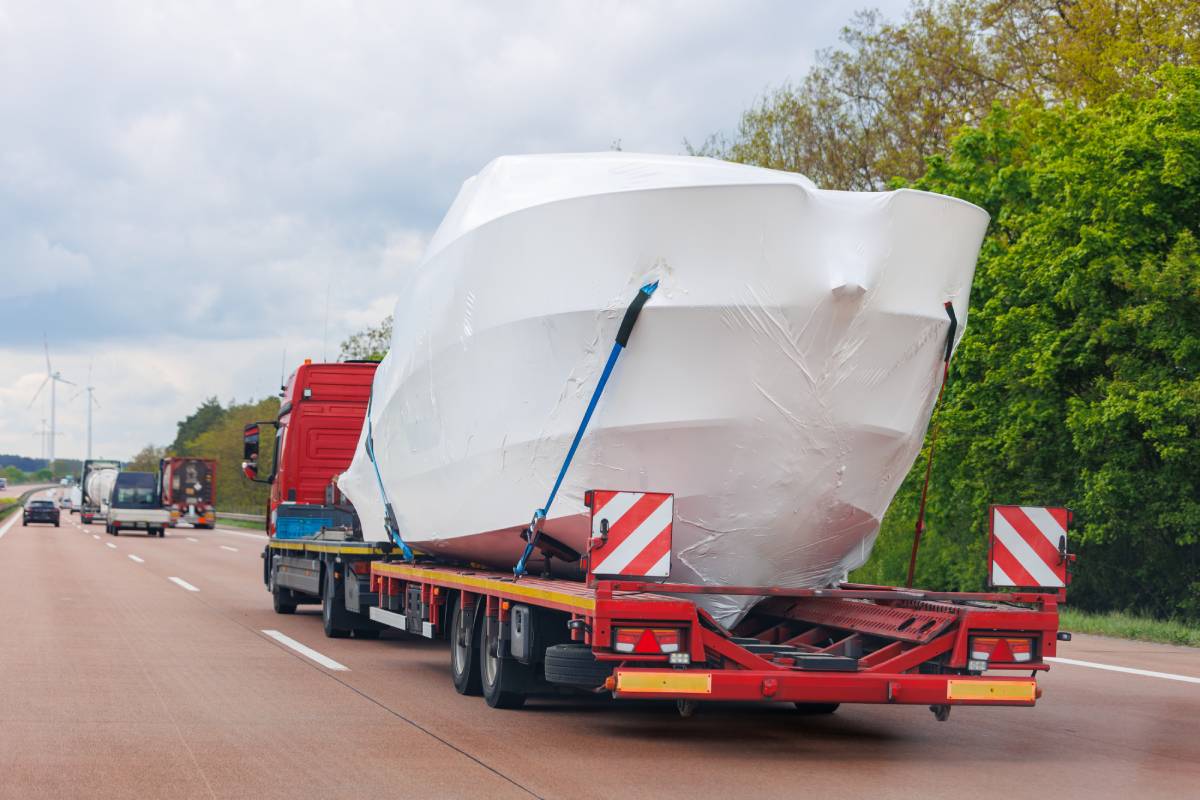How to Safely Transport a Yacht Interstate
Transporting a yacht interstate is a complex process that requires careful planning, specialized equipment, and professional expertise. Whether you are relocating your yacht for seasonal cruising, a sale, or maintenance, ensuring its safe transportation is critical to avoiding damage and unnecessary costs.
This guide will walk you through the steps to safely transport a yacht interstate, covering essential preparations, transport options, legal requirements, and expert tips.
Planning Your Yacht Transport
Assessing Your Yacht’s Size and Transport Requirements
The first step in transporting a yacht is to evaluate its specifications, including:
- Length – Longer yachts require specialized trailers and permits.
- Beam (Width) – If your yacht exceeds a certain width (often around 2.5m in Australia), it may require oversize load permits and escort vehicles.
- Height – If your yacht is over 4.3m when loaded onto a trailer, route planning must consider low bridges and power lines.
- Weight – The total weight of your yacht will determine the type of truck and trailer needed.
Choosing the Right Transport Method
There are two primary methods for interstate yacht transportation:
- Road Transport – The most common method for medium-sized yachts, using specialized trailers and trucks.
- Sea Transport – If moving between coastal states, you may opt for a yacht delivery service where a crew sails it to the destination.
Preparing Your Yacht for Transport
Cleaning and Inspecting Your Yacht
Before transportation, give your yacht a thorough cleaning and inspection.
- Remove barnacles and marine growth to prevent biosecurity issues.
- Check for pre-existing damage and take photos for documentation.
- Ensure the hull is in good condition and dry to prevent unnecessary weight.
Securing Loose Items
To prevent damage during transport, secure or remove:
- Interior items – Loose furniture, dishes, and décor should be packed away.
- Exterior equipment – Antennas, radars, and rigging should be dismantled or secured.
- Fuel and water tanks – Drain or minimize liquid levels to reduce weight and prevent leaks.
Protecting Fragile Parts
Wrap sensitive components like windshields, electronics, and navigation equipment with protective coverings. If transporting in cold weather, consider shrink-wrapping your yacht to prevent exposure to the elements.
Hiring a Professional Yacht Transporter
Choosing a Reputable Yacht Transport Company
Hiring a professional transport company ensures safe handling and compliance with legal requirements. Look for:
- Experience with oversized yacht transport – Ask for previous case studies or customer reviews.
- Proper licensing and insurance – Verify the company has the necessary transport permits and comprehensive insurance coverage.
- Specialized equipment – Ensure they use hydraulic trailers, padded supports, and experienced truck drivers.
Getting an Accurate Quote
Obtain multiple quotes and ask about:
- Transport fees – Pricing varies based on yacht size, distance, and permits.
- Insurance coverage – Understand what is covered in case of damage.
- Additional costs – Some companies charge extra for escort vehicles, permits, and loading/unloading fees.
Understanding Legal and Permit Requirements
Oversized Load Regulations
In Australia, yachts exceeding standard dimensions require special permits:
- Width – Anything over 2.5m typically requires an oversize permit.
- Height – Loads over 4.3m must comply with route restrictions.
- Weight – Heavier loads may require special transport approvals.
State-Specific Transport Rules
Each Australian state has different regulations regarding oversized loads. Ensure you or your transport company obtain the correct permits from:
- National Heavy Vehicle Regulator (NHVR) – For interstate transport regulations.
- State Transport Authorities – Such as Transport for NSW, VicRoads, or Queensland Transport.
Escort Vehicles and Route Planning
For large yachts, escort vehicles or pilot cars may be required. These vehicles ensure safe passage through bridges, tunnels, and highways. Professional transport companies handle these arrangements to ensure a smooth journey.
Loading and Unloading the Yacht
Using Cranes and Lifting Equipment
Depending on your yacht’s size, it may need to be craned onto a trailer. Marina facilities or specialized lifting services can help with this process. Ensure:
- Slings and lifting points are correctly placed to avoid hull damage.
- A professional rigger or marina team supervises the operation.
Securing the Yacht on the Trailer
Proper securing is crucial to prevent movement during transit:
- Use heavy-duty straps to hold the yacht in place.
- Support the keel and hull with padded blocks to distribute weight evenly.
- Check tyre pressures and trailer brakes to ensure a stable load.
Unloading at the Destination
Once at the destination marina or boatyard:
- Inspect the yacht for any transport-related damage before accepting delivery.
- Reassemble and reinstall any removed parts.
- Perform a systems check before launching the yacht back into the water.
Additional Safety Tips for Yacht Transport
Weather Considerations
- Avoid transporting during extreme weather conditions.
- Check road conditions for potential delays.
- If moving by sea, consult marine forecasts to prevent rough sailing.
Communicating with the Transporter
- Maintain open communication with the transport company for updates.
- Ensure you are reachable on transport day for any last-minute adjustments.
Insurance and Damage Claims
- Take photos before and after transport as proof of condition.
- If damage occurs, document it immediately and file an insurance claim.
Cost Considerations and Route Examples
Understanding the financial aspect of yacht transportation is crucial for budgeting. While actual costs vary widely depending on the yacht’s size, weight, transport distance, permit fees, and additional services, here are some examples to provide context for common interstate routes in Australia:
Melbourne to Sydney
This route is among the most frequently travelled in southeastern Australia.
- Distance and Logistics: The relatively moderate distance and well-established transport routes help keep costs manageable.
- Estimated Costs: For a standard-sized yacht, professional transport services might charge approximately AUD 4,000 to AUD 7,000.
- Factors Affecting Cost: Variables include the specific dimensions of the yacht, additional escort vehicle fees for oversized loads, and any specialized handling required.
Melbourne to Brisbane
Transporting a yacht from Melbourne to Brisbane introduces additional logistical considerations:
- Longer Distance: This route covers a greater distance, often necessitating longer travel times and potential overnight stops for the transport crew.
- Estimated Costs: Expect costs to range from AUD 6,000 to AUD 12,000.
- Additional Considerations: The increased distance typically results in higher fuel costs, additional permit fees, and potentially extra charges for extended escort services, depending on the size and complexity of the yacht.
Perth to Melbourne
Moving a yacht from Perth to Melbourne is one of the most challenging and expensive routes due to the vast distance across Australia:
- Route Challenges: This route spans nearly the entire width of the country, involving multiple state jurisdictions, diverse road conditions, and extended travel times.
- Estimated Costs: For such long-distance transport, prices can range from AUD 10,000 to AUD 20,000 or more.
- Key Cost Drivers: Factors include the extended travel distance, the necessity for multiple permits across different states, potential overnight accommodation for the crew, and higher fuel consumption. Additionally, the logistical complexity of planning a safe and compliant route across such a distance can add to the overall expense.
General Cost Considerations
While the examples above provide a framework, actual costs are influenced by:
- Yacht Specifications: Larger, heavier yachts require more robust transport equipment and often incur higher fees.
- Special Requirements: Custom loading/unloading procedures, additional insurance coverage, and modifications for secure transport can further increase costs.
- Market Variability: Seasonal demand, fluctuating fuel prices, and regional permit fees may also impact the overall cost.
It is advisable to request detailed, itemized quotes from several reputable transport companies. This approach ensures transparency and helps you compare services based on value and reliability rather than just price.
Conclusion
Transporting a Yacht Interstate involves careful planning, appropriate equipment, and professional expertise.
For a smooth relocation process, it’s essential to prepare your yacht properly, hire an experienced transport company like Interstate Towing Australia, secure any necessary permits, and implement safe loading and unloading procedures.
Whether you are moving your yacht for a new adventure or for maintenance, following these steps will help you minimize risks and ensure that it arrives safely at its destination.











Post Comment